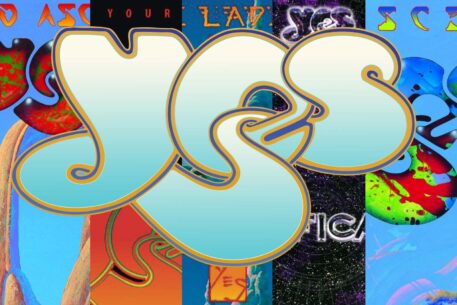John M. Gouldin is breaking down five less-heralded albums Yes released between 1996-2001 in a multi-part series, beginning with ‘Keys to Ascension’ and ‘Keys to Ascension 2′:

There is more to the band Yes than lingering hits “Roundabout” and “Owner of a Lonely Heart.” The group’s history is a string of Escher-like twists and ironies that run through five decades and 23 studio albums.
Though best-known as ’70s progressive-rock archetypes, Yes prospered an additional 15 years as arena-rock heavyweights until that era passed around 1994. Since then, they’ve continued to tour and record, helping popularize multi-album tours and progressive rock cruises along the way.
Rather than transitional periods interspersed with stability, the band’s history (YesHistory, an affectation) is one of more or less perpetual change since their third album, in terms of personnel and sound shifts. They’ve featured four-, five-, six-, and eight-man lineups. There have been 17 official members, with several cardholders leaving and returning multiple times. As a result, the same lineup has passed onto the next record only five of those 23 times. Both stats depend on your counting criteria. Little about Yes has a simple explanation.
The era from 1996 to 2001 remains a largely overlooked span, although a string of five studio albums full of surprising and distinct music were released in quick succession, as members responded to a series of challenges that threatened the very existence of the band. Such a prolific musical period deserves examination. The background story inspiring the music serves as a continuing example of the Houdini-like history of the organization called Yes.
In 1994, the group was undergoing another personnel shift, losing their guitarist and keyboardist. Vocalist and hippified guru Jon Anderson responded by facilitating the reorganization of a fan-favored past lineup, with long-time drummer Alan White and legendary co-founding bassist Chris Squire reuniting with the virtuoso talents of keyboardist Rick Wakeman and guitarist Steve Howe.
These five helped define progressive music in the 1970s, and their reformation hinted at a return to that genre after more than a decade of hitting home runs off singles by playing a more radio-palatable rock. They gathered in late ’95/early ’96 and made their first new music together since 1979, further solidifying the concept with a three-night showcase of live music in March 1996 in San Luis Obispo, Calif. This provided the material which make up the first two of the five albums in six years.
‘KEYS TO ASCENSION’
Released: October 1996
Players: Jon Anderson, Alan White, Steve Howe, Chris Squire, Rick Wakeman
Producers: Yes and Tom Fletcher
The heralded return of the old/new lineup came as a double compact disc, with a comforting old-school cover by regular ally Roger Dean. This concealed an unfortunate flaw: In a bad management decision, Keys to Ascension was birthed in the eternally dubious format of part live and part studio music, which tends to enhance neither and distract from both.
The live material covered a disc and a half of (most of) the San Luis Obispo concert recordings, including a few interesting, long unexplored choices plucked from their extensive catalog. Most exciting was the almost 30 minutes of new music that came on the second disc, situated after the live concert, courting the perception of lesser importance.
Yes helped regularize long-form songs in the 1970s and wisely include one – their first since 1977 – with “That, That Is,” a collection of sub-sets finishing at 19:14. That and the 10-minute “Be the One” could be called ’90s neo-prog, and had little in common with 1994’s previous Talk album beyond Jon Anderson’s voice.
A certain tautness in the presentation can be attributed to reintegrating and a desire to avoid referencing their collective past. Neither are instant Yes classics, but when taken as an opening statement, it is understandable the pervading fan-sentiment of the time was one of genuine interest in what the future might hold.
‘KEYS TO ASCENSION 2’
Released: November 1997
Players: Jon Anderson, Alan White, Steve Howe, Chris Squire, Rick Wakemen
Producers: Yes and Billy Sherwood
Soon after Keys to Ascension went public, Yes again gathered, this time to record a full 45 minutes of new material. The marketing plan followed the same format and mixed the remaining live songs (from shows now over a year old) with the new work. This time, Rick Wakeman expressed public excitement over the new sessions, calling the work superior to the first go, deserving its own identity.
The record label prevailed, designing the album with the connective name and similar Roger Dean cover. As before, the first disc held San Luis Obispo concert cuts, including a lovely update of “Turn of the Century.” The second disc didn’t quite conceal what was essentially the first studio album by this venerated version of Yes since Jimmy Carter was president.
“Mind Drive,” another long-form song, receives the most attention into today, but “Footprints” makes the startling impression. Out of the blue, with its odd corn-fed a cappella introduction sprawling all out of recognition into full-blown prog, “Footprints” is the cut that most loudly bespeaks the lost potential of this particular lineup so long apart. It’s original and a Yes hidden gem. None of the five songs on offer was of the type to serve as a single to promote the album, a clear sign of prog.
In hindsight, Wakeman was correct. Sounding invested and creative, if still a bit tentative, the second disc was a notable comeback album that completely avoided that term. Keys to Ascension 2 rests in the group’s catalog as an artifact of prog arrangements that fits nicely as a post-Tormato followup (the last album featuring these five, from 1979), delayed and updated.
At the time, it sold less than the original Keys to Ascension. The studio music got lost, hidden on what people still generally view as two live albums. This however is jumping ahead of the story a bit. Again, little about YesHistory happened in a smooth, linear fashion.
Returning to the spring of 1997, the reformation of the classic-era lineup was in full swing with Keys to Ascension teasing the crowd and Keys to Ascension 2 finished and waiting for an autumn release. Because of the relative wealth of recent output, there was a definite impression that the individuals still had the magic and desire to maneuver this august organization into the new millennium.
Turning to returning personalities as a way to the future seemed suitably Yes-like as a story, and an observer that spring might easily conclude that the band with a history of more irony than a Mark Twain story had navigated a smooth course out of its “It Can Happen” and “Lift Me Up” sound design and was forging a new beginning using their collective past.
Then it all fell apart.
Click here for John M. Gouldin’s four-part series on one of Yes’ most overlooked eras, with thoughts on ‘Keys to Ascension and Keys to Ascension 2,’ ‘Open Your Eyes,’ ‘The Ladder’ and ‘Magnification.’
- The Story of the Only Yes EP: ‘From a Page’ - August 18, 2023
- New Yes History: A Moment to Breathe, A Moment to Listen - May 15, 2023
- Returning to One of Yes’ Most Overlooked Eras: ‘Magnification’ - February 13, 2023


